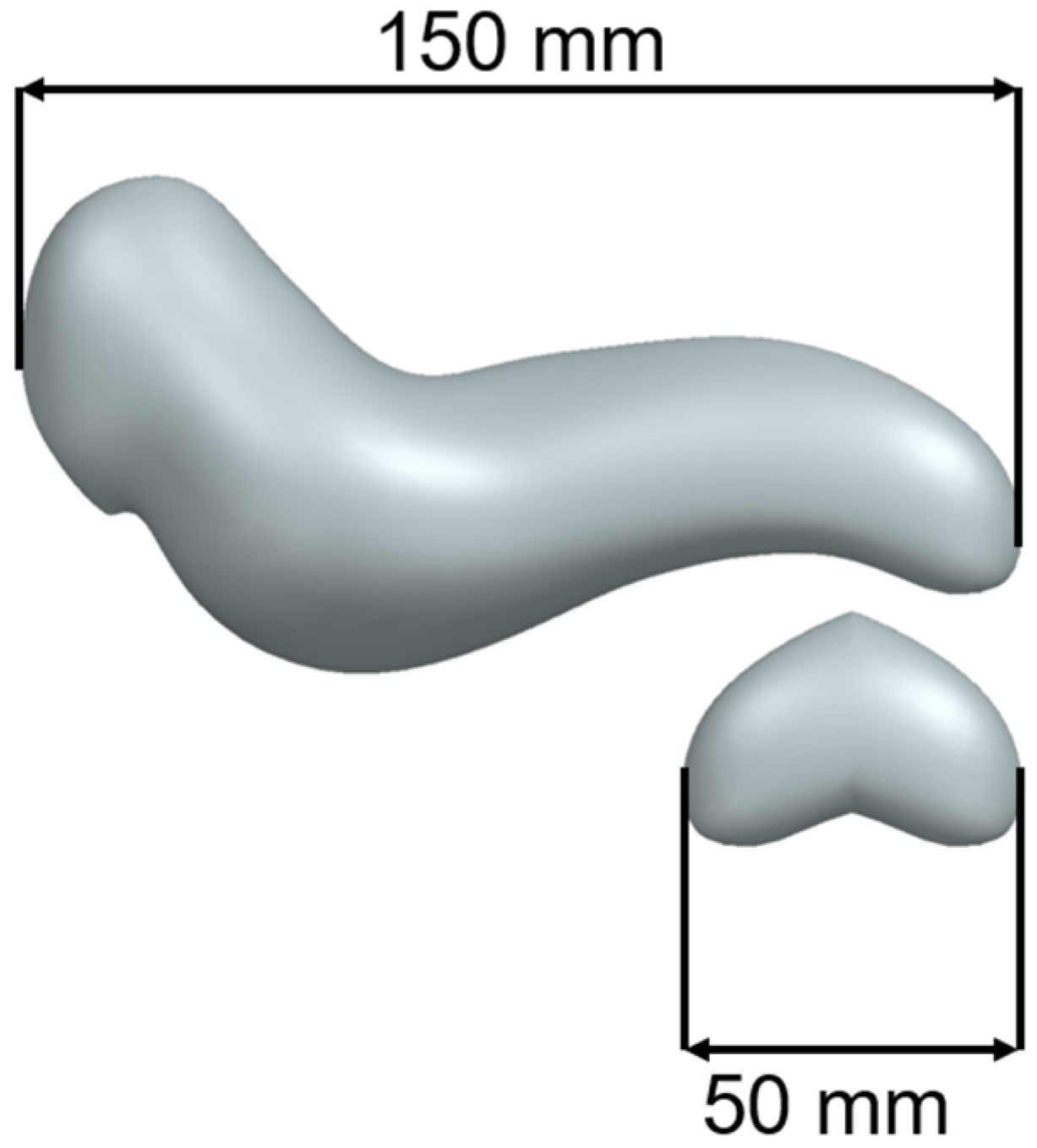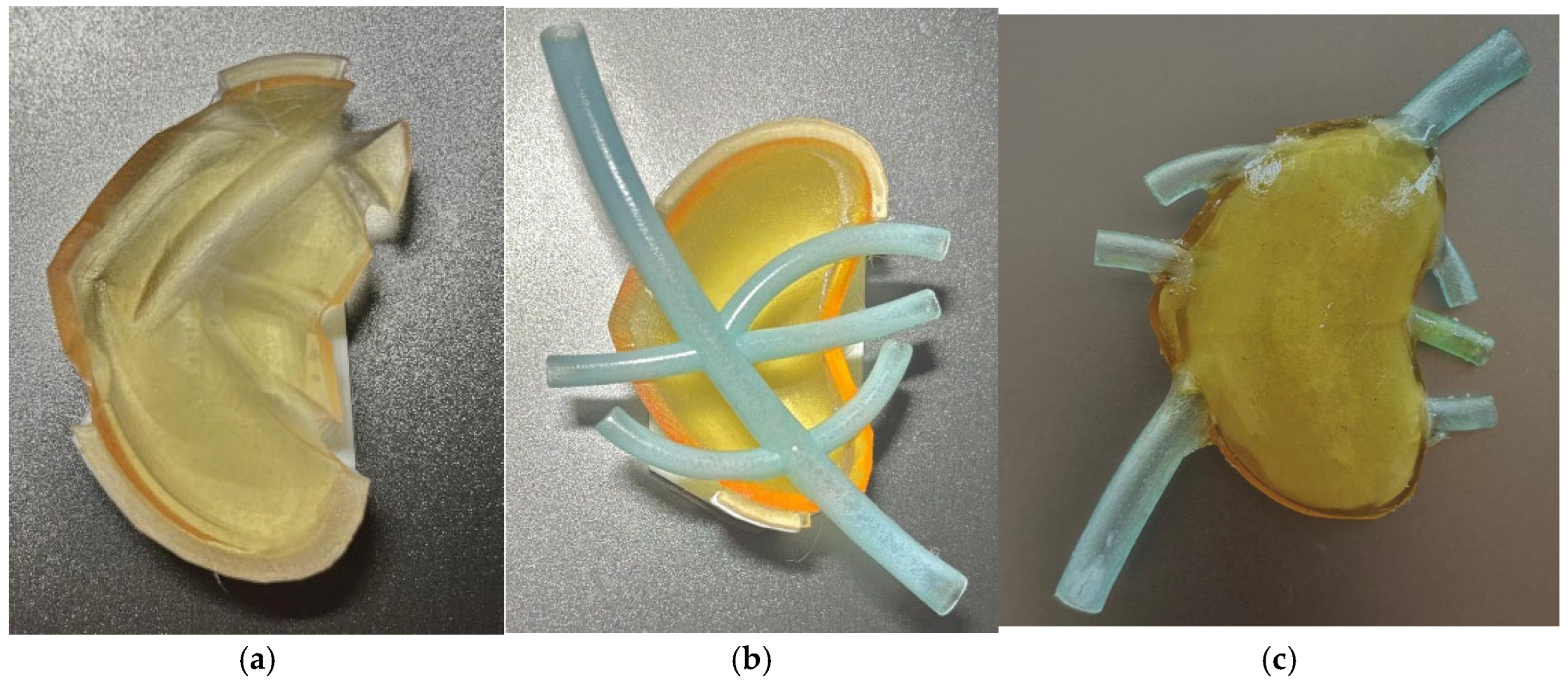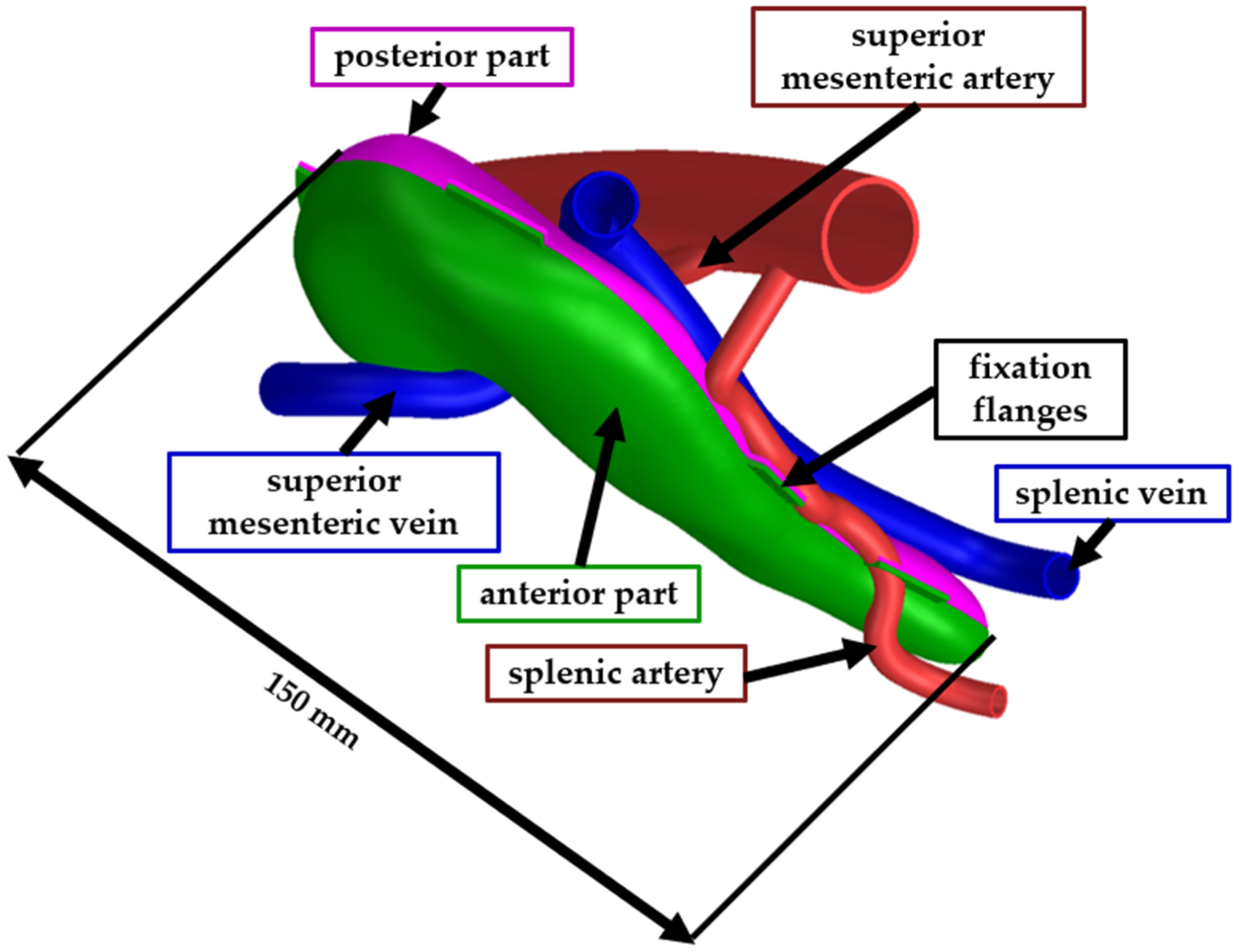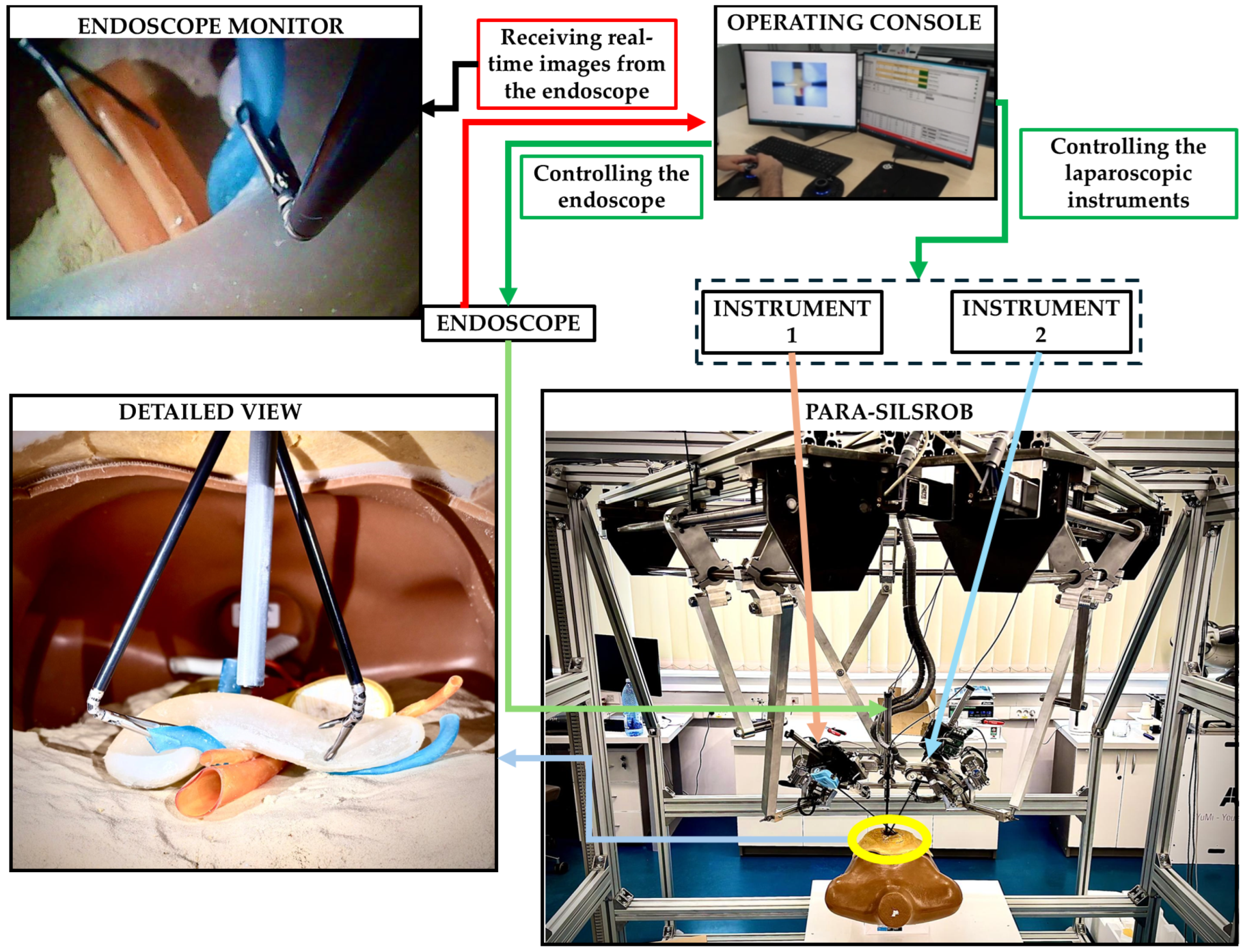A 3D-Printed Anatomical Pancreas Model for Robotic-Assisted Minimally Invasive Surgery
Abstract
1. Introduction
1.1. Background and Motivation
1.2. Importance of Preoperative Surgical Planning and Surgical Training
1.3. Importance of 3D-Printed Phantom Models
1.4. Objectives of the Study
- Segmentation of CT/MRI data to design a 3D patient-specific phantom model of the pancreas with internal and external anatomical details (vascular structures and tumours).
- Optimisation of the Pancreatic Structure by generating different hollow shell structures and evaluating their mechanical behaviour.
- Generation of different internal structures and evaluate their mechanical properties.
- Development of a 3D design methodology to ensure the reproducibility and adaptability of the model for different applications.
- Evaluation of the Phantom Model for Surgical Applications.
- Evaluation of the feasibility of the phantom model in practical surgical applications based on the surgeon’s feedback.
- Comparison of the behaviour of the phantom model with the real pancreas based on surgeons’ feedback.
- Validation of the phantom model using the PARA-SILSROB parallel robot for SILS.
- Contribution to Pancreatic Surgery Research.
- Definition of a practical framework for future research and development of 3D printed soft tissue phantom models.
2. Materials and Methods
2.1. Material Selection
2.2. Pancreas Phantom Model—Design and Manufacturing Considerations
2.2.1. The 3D Modelling Process of the Pancreatic Surface
- The preservation of the anatomical shape of the pancreas.
- The assurance of a uniform and printable surface.
- The reduction of excessive surface complexity to facilitate the 3D printing process.
2.2.2. Creating a Reduced Test Model
2.2.3. Initial Design: Vascularised Model with 1.5 mm Thick Hollow Shell with Support Material Inside
2.2.4. Second Design: Vascularised Model with 1.5 mm Thick Hollow Shell with Hydrogel Inside
2.2.5. Final Design—Full Scale Vascularised Pancreas with 2 mm Thick Hollow Shell and Hydrogel Inside
3. Results and Discussion
3.1. Evaluation of the Initial Phantom Model
- The stiffness of the structure. The feedback from the surgeons provided valuable insights into the mechanical behaviour of the printed test model. The assessment was performed qualitatively, as the surgeons compared the tactile sensation of the model with their experience of handling the human pancreas during surgery. According to their observations, the internal structure was noticeably stiffer than that of real pancreatic tissue. As a result, redesigning the internal composition became a top priority.
- Exterior surface smoothness. The printed test model successfully replicated the general texture of the pancreatic capsule; however, minor surface irregularities were observed, requiring additional post-processing. The 1.5 mm thick hollow shell was evaluated qualitatively by the surgeons, who concluded that it exhibited realistic surface behaviour consistent with their surgical experience.
- Anatomical accuracy. Even if the structure of the pancreatic capsule was replicated, the surgeons requested more anatomical details, such as vascular structures, to be included in the model, that could further be personalised with anatomical variants in the future. The inclusion of vascular structures is essential for preoperative surgical planning and for surgical training.
3.2. Evaluation of the Vascularised Model with 2 mm Thick Hollow Shell and Hydrogel Inside
3.3. Evaluation of the Final Design—Full Scale Vascularised Pancreas with 2 mm Thick Hollow Shell and Hydrogel Inside
- Formulation 1: Softest sample; baseline for very soft tissues
- Formulation 2: Mild elasticity—useful near the lower physiological range
- Formulation 3: Strong elastic behaviour—useful midpoint
- Formulation 5: Intermediate consistency, close to the desired texture
- Formulation 7: Firm, fibrotic pancreas (e.g., pancreatitis)
- Formulation 9: Reinforced structure but still soft
- Formulation 10: Strong but not brittle—can represent stiff pathology
- Formulation 11: Closest to the consistency of a healthy pancreas
- Formulation 13: Mid-firm elastic—useful for borderline fibrotic conditions
- Formulation 14: Durable and elastic.
3.4. Experimental Evaluation of the Phantom Model
4. Conclusions and Further Work
Author Contributions
Funding
Institutional Review Board Statement
Informed Consent Statement
Data Availability Statement
Conflicts of Interest
References
- Longnecker, D.S. Anatomy and Histology of the Pancreas; Pancreapedia: Exocrine Pancreas Knowledge Base. 2021. Available online: https://pancreapedia.org/reviews/anatomy-and-histology-of-pancreas (accessed on 4 May 2025).
- Available online: https://www.iarc.who.int/cancer-type/pancreatic-cancer/ (accessed on 30 April 2025).
- Available online: https://gco.iarc.fr/en (accessed on 5 May 2025).
- Hays, S.B.; Rojas, A.E.; Hogg, M.E. Robotic pancreas surgery for pancreatic cancer. Int. J. Surg. 2024, 110, 6100–6110. [Google Scholar] [CrossRef] [PubMed]
- Marcucci, F.; Carillo, G.; Sánchez-Velázquez, P.; Garcia-Picazo, A.; Burdio, F.; Ielpo, B. Practical Approaches to High-Risk Anastomoses in Robotic Pancreatoduodenectomy. Ann. Surg. Oncol. 2025; Online ahead of print. [Google Scholar] [CrossRef] [PubMed]
- Vaida, C.; Pisla, D.; Schadlbauer, J.; Husty, M.; Plitea, N. Kinematic analysis of an innovative medical parallel robot using study parameters. In New Trends in Medical and Service Robots. Mechanisms and Machine Science; Wenger, P., Chevallereau, C., Pisla, D., Bleuler, H., Rodić, A., Eds.; Springer: Cham, Switzerland, 2016; Volume 39, Available online: https://www.springerprofessional.de/en/new-trends-in-medical-and-service-robots/10075546 (accessed on 4 May 2025).
- Pisla, D.; Calin, V.; Birlescu, I.; Hajjar, N.A.; Gherman, B.; Radu, C.; Plitea, N. Risk Management for the Reliability of Robotic Assisted Treatment of Non-resectable Liver Tumors. Appl. Sci. 2020, 10, 52. [Google Scholar] [CrossRef]
- Pisla, D.; Popa, C.; Pusca, A.; Ciocan, A.; Gherman, B.; Mois, E.; Cailean, A.-D.; Vaida, C.; Radu, C.; Chablat, D.; et al. On the Control and Validation of the PARA-SILSROB Surgical Parallel Robot. Appl. Sci. 2024, 14, 7925. [Google Scholar] [CrossRef]
- Nguyen, A.H.; Melstrom, L.G. Use of imaging as staging and surgical planning for pancreatic surgery. Hepatobiliary Surg. Nutr. 2020, 9, 603–614. [Google Scholar] [CrossRef] [PubMed]
- Andolfi, C.; Plana, A.; Kania, P.; Banerjee, P.P.; Small, S. Usefulness of Three-Dimensional Modeling in Surgical Planning, Resident Training, and Patient Education. J. Laparoendosc. Adv. Surg. Tech. Part A 2017, 27, 512–515. [Google Scholar] [CrossRef] [PubMed]
- Clark, W.; Hernandez, J.; McKeon, B.A.; Kahn, A.; Morton, C.; Toomey, P.; Mullinax, J.; Ross, S.; Rosemurgy, A. Surgery residency training programmes have greater impact on outcomes after pancreaticoduodenectomy than hospital volume or surgeon frequency. HPB 2010, 12, 68–72. [Google Scholar] [CrossRef] [PubMed] [PubMed Central]
- Ciocan, R.A.; Ciocan, A.; Zaharie, F.V.; Popa, C.; Schlanger, D.; Alexa, A.; Ionescu, D.; Hajjar, N.A. Perioperative Management of Patients with Pancreatic Cancer—The ERAS Protocols. Chirurgia 2022, 117, 415–422. [Google Scholar] [CrossRef] [PubMed]
- Russell, T.B.; Labib, P.L.; Aroori, S. Selected pre-operative factors which affect pancreaticoduodenectomy outcomes: A systematic review. Ann. Pancreat. Cancer 2021, 4, 1–16. [Google Scholar] [CrossRef]
- Bati, A.H.; Guler, E.; Ozer, M.A.; Govsa, F.; Erozkan, K.; Vatansever, S.; Ersin, M.S.; Elmas, Z.N.; Harman, M. Surgical planning with patient-specific three-dimensional printed pancreaticobiliary disease models—Cross-sectional study. Int J Surg. 2020, 80, 175–183. [Google Scholar] [CrossRef] [PubMed]
- Song, C.; Min, J.H.; Jeong, W.K.; Kim, S.H.; Heo, J.S.; Han, I.W.; Shin, S.H.; Yoon, S.J.; Choi, S.Y.; Moon, S. Use of individualized 3D-printed models of pancreatic cancer to improve surgeons’ anatomic understanding and surgical planning. Eur. Radiol. 2023, 33, 7646–7655. [Google Scholar] [CrossRef] [PubMed]
- Available online: https://www.stratasys.com/en/3d-printers/printer-catalog/polyjet/j5-medijet-printer/ (accessed on 5 May 2025).
- Available online: https://www.stratasys.com/en/materials/materials-catalog/polyjet-materials/elastico/ (accessed on 5 May 2025).
- Kumar, H.; DeSouza, S.V.; Petrov, M.S. Automated pancreas segmentation from computed tomography and magnetic resonance images: A systematic review. Comput. Methods Programs Biomed. 2019, 178, 319–328. [Google Scholar] [CrossRef] [PubMed]
- Available online: https://plm.sw.siemens.com/en-US/nx/ (accessed on 15 March 2025).
- Bello, A.B.; Kim, D.; Kim, D.; Park, H.; Lee, S.H. Engineering and Functionalization of Gelatin Biomaterials: From Cell Culture to Medical Applications. Tissue Eng. Part B Rev. 2020, 26, 164–180. [Google Scholar] [CrossRef] [PubMed]
- Cao, N.; Yang, X.; Fu, Y. Effects of various plasticizers on mechanical and water vapor barrier properties of gelatin films. Food Hydrocoll. 2009, 23, 729–735. [Google Scholar] [CrossRef]
- Kurniawan, L.; Qiao, G.G.; Zhang, X. Formation of Wheat Gluten–Polycaprolactone Biodegradable Blends. Food Hydrocoll. 2009, 23, 729–735. [Google Scholar] [CrossRef]
- Jawli, A.; Aldehani, W.; Nabi, G.; Huang, Z. Tissue-Mimicking Material Fabrication and Properties for Multiparametric Ultrasound Phantoms: A Systematic Review. Bioengineering 2024, 11, 620. [Google Scholar] [CrossRef] [PubMed]
- Sarvazyan, A.P.; Rudenko, O.V.; Swanson, S.D.; Fowlkes, J.B.; Emelianov, S.Y. Shear wave elasticity imaging: A new ultrasonic technology of medical diagnostics. Ultrasound Med. Biol. 1998, 24, 1419–1435. [Google Scholar] [CrossRef] [PubMed]
- Kawada, N.; Tanaka, S. Elastography for the pancreas: Current status and future perspective. World J. Gastroenterol. 2016, 22, 3712–3724. [Google Scholar] [CrossRef] [PubMed]
- Choudhury, A.; Sonawane, P.; Chaudhari, N.; Bharati, A.; Sharma, P. Shear Wave Elastography of the Pancreas in Healthy Adults: Evaluation of the Pancreatic Head and Body. Ultrasound Int. Open 2022, 8, E58–E63. [Google Scholar] [CrossRef]
- Johnson, P.; Schmidt, D.; Duvvuri, U. Output control of da Vinci surgical system’s surgical graspers. J. Surg. Res. 2014, 186, 56–62. [Google Scholar] [CrossRef]








| Water (%) | Gelatine (%) | Agar (%) | Glycerol (%) | Expected Behaviour | |
|---|---|---|---|---|---|
| Formulation 1 | 88.60% | 3.90% | 1.40% | 6.10% | Soft, flexible |
| Formulation 2 | 87.50% | 5.30% | 1.60% | 5.60% | Moderate elasticity |
| Formulation 3 | 84.70% | 6.40% | 3.20% | 5.70% | Strong, elastic |
| Formulation 4 | 83.40% | 5.00% | 3.00% | 8.60% | Firm |
| Formulation 5 | 83.30% | 6.30% | 4.70% | 5.60% | Hydrated, soft |
| Formulation 6 | 81.70% | 6.50% | 4.90% | 6.90% | Tough, less flexible |
| Formulation 7 | 79.50% | 7.90% | 6.70% | 6.00% | Soft but with structure |
| Formulation 8 | 83.00% | 5.00% | 1.50% | 10.50% | Slightly firm |
| Formulation 9 | 78.80% | 6.00% | 6.30% | 8.90% | Soft, slight reinforcement |
| Formulation 10 | 78.70% | 7.00% | 8.30% | 5.90% | Strong but not too brittle |
| Formulation 11 | 84.10% | 6.00% | 3.20% | 6.70% | Balanced, medium-soft |
| Formulation 12 | 85.90% | 5.20% | 4.60% | 4.30% | Most rigid, good shape retention |
| Formulation 13 | 82.80% | 5.90% | 4.70% | 6.60% | Firm, moderate elasticity |
| Formulation 14 | 81.30% | 6.50% | 6.40% | 5.80% | Moderate elasticity & durability |
| Formulation 15 | 78.10% | 7.70% | 8.20% | 5.90% | Most rigid and stable |
| Formulation | Sample | Median Vs | Median E | Median ATT | |||
|---|---|---|---|---|---|---|---|
| No. | No. | [m/s] | IQR/M | [kPa] | IQR/M | [dB/cm/MHz] | IQR/M |
| 1 | 1_1 | 1.28 | 46.00 | 4.91 | 107.00 | 0.13 | 41.00 |
| 1_2 | 2.24 | 61.00 | 15.05 | 115.00 | 0.08 | 158.00 | |
| 1_3 | 1.40 | 30.00 | 5.87 | 62.00 | 0.15 | 20.00 | |
| average | 1.64 | 8.61 | 0.12 | ||||
| 2 | 2_1 | 1.24 | 50.00 | 4.60 | 115.00 | 0.03 | 245.00 |
| 2_2 | 1.65 | 63.00 | 8.13 | 106.00 | 0.07 | 59.00 | |
| 2_3 | 0.99 | 37.00 | 2.92 | 80.00 | 0.08 | 85.00 | |
| average | 1.29 | 5.22 | 0.06 | ||||
| 3 | 3_1 | 1.16 | 59.00 | 4.03 | 116.00 | 0.08 | 139.00 |
| 3_2 | 1.88 | 36.00 | 10.55 | 69.00 | 0.09 | 117.00 | |
| 3_3 | 1.73 | 31.00 | 9.00 | 58.00 | 0.09 | 114.00 | |
| average | 1.59 | 7.86 | 0.08 | ||||
| 5 | 5_1 | 1.66 | 69.00 | 8.29 | 136.00 | 0.15 | 96.00 |
| 5_2 | 1.22 | 41.00 | 4.45 | 85.00 | 0.09 | 88.00 | |
| 5_3 | 1.81 | 43.00 | 9.77 | 87.00 | 0.14 | 89.00 | |
| average | 1.56 | 7.50 | 0.12 | ||||
| 7 | 7_1 | 1.32 | 20.00 | 5.24 | 42.00 | 0.13 | 28.00 |
| 7_2 | 1.56 | 24.00 | 7.27 | 48.00 | 0.16 | 56.00 | |
| 7_3 | 1.38 | 11.00 | 5.73 | 22.00 | 0.13 | 33.00 | |
| average | 1.42 | 6.08 | 0.14 | ||||
| 9 | 9_1 | 2.33 | 34.00 | 16.20 | 62.00 | 0.24 | 17.00 |
| 9_2 | 1.75 | 49.00 | 9.25 | 98.00 | 0.19 | 12.00 | |
| 9_3 | 1.77 | 71.00 | 9.50 | 166.00 | 0.06 | 165.00 | |
| average | 1.95 | 11.65 | 0.16 | ||||
| 10 | 10_1 | 1.60 | 52.00 | 7.64 | 113.00 | 0.16 | 47.00 |
| 10_2 | 1.40 | 76.00 | 5.97 | 163.00 | 0.12 | 104.00 | |
| 10_3 | 1.21 | 73.00 | 4.38 | 184.00 | 0.36 | 14.00 | |
| average | 1.40 | 5.99 | 0.21 | ||||
| 11 | 11_1 | 1.47 | 51.00 | 6.55 | 115.00 | 0.20 | 23.00 |
| 11_2 | 1.63 | 39.00 | 7.94 | 84.00 | 0.24 | 67.00 | |
| 11_3 | 1.74 | 50.00 | 9.11 | 104.00 | 0.17 | 28.00 | |
| average | 1.61 | 7.86 | 0.20 | ||||
| 13 | 13_1 | 2.94 | 18.00 | 25.95 | 36.00 | 0.27 | 31.00 |
| 13_2 | 1.71 | 67.00 | 8.87 | 132.00 | 0.20 | 89.00 | |
| 13_3 | 1.80 | 29.00 | 9.72 | 62.00 | 0.13 | 74.00 | |
| average | 2.15 | 14.85 | 0.20 | ||||
| 14 | 14_1 | 1.17 | 47.00 | 4.14 | 113.00 | 0.13 | 100.00 |
| 14_2 | 1.57 | 67.00 | 7.46 | 148.00 | 0.14 | 88.00 | |
| 14_3 | 1.78 | 57.00 | 9.54 | 102.00 | 0.15 | 32.00 | |
| average | 1.51 | 7.05 | 0.14 | ||||
| Assessment element | Surgeon 1 | Surgeon 2 | Surgeon 3 | Surgeon 4 | Surgeon 5 | Mean | SD |
|---|---|---|---|---|---|---|---|
| Q1. Phantom model stiffness | 8 | 7 | 7 | 9 | 8 | 7.8 | 0.84 |
| Q2. Size and shape of model | 8 | 9 | 8 | 9 | 8 | 8.4 | 0.55 |
| Q3. Ease of instrument manipulation during simulation | 8 | 8 | 8 | 8 | 8 | 8 | 0 |
| Q4. Educational and clinical utility of the model | 7 | 7 | 9 | 9 | 9 | 8.2 | 1.1 |
| Q5. Potential for refinement to increase anatomical or functional realism | 8 | 8 | 9 | 9 | 9 | 8.6 | 0.55 |
| Procedure | Material Usage | Time Duration | Estimative Costs (EUR) |
|---|---|---|---|
| Shell model printing | Materials—144 gr | 14 h 14 m | 30 EUR (200 Eur per kg) |
| Support—376 gr | 60 EUR (150 EUR per kg) | ||
| Hydrogel | Mixture based on formulation 11 | 1 h | 10 EUR |
| Assembly | Glueing | 24 h | 1 EUR |
| Hydrogel insertion in the pancreas mold | Hydrogel | 0.5 h | - |
| Pancreas mold finish | - | 12 h | - |
| TOTAL | 51 h 45 m | Approx. 100 EUR | |
Disclaimer/Publisher’s Note: The statements, opinions and data contained in all publications are solely those of the individual author(s) and contributor(s) and not of MDPI and/or the editor(s). MDPI and/or the editor(s) disclaim responsibility for any injury to people or property resulting from any ideas, methods, instructions or products referred to in the content. |
© 2025 by the authors. Licensee MDPI, Basel, Switzerland. This article is an open access article distributed under the terms and conditions of the Creative Commons Attribution (CC BY) license (https://creativecommons.org/licenses/by/4.0/).
Share and Cite
Vaida, C.; Ciocan, A.; Caprariu, A.; Radu, C.; Hajjar, N.A.; Pisla, D. A 3D-Printed Anatomical Pancreas Model for Robotic-Assisted Minimally Invasive Surgery. J. Funct. Biomater. 2025, 16, 207. https://doi.org/10.3390/jfb16060207
Vaida C, Ciocan A, Caprariu A, Radu C, Hajjar NA, Pisla D. A 3D-Printed Anatomical Pancreas Model for Robotic-Assisted Minimally Invasive Surgery. Journal of Functional Biomaterials. 2025; 16(6):207. https://doi.org/10.3390/jfb16060207
Chicago/Turabian StyleVaida, Calin, Andra Ciocan, Andrei Caprariu, Corina Radu, Nadim Al Hajjar, and Doina Pisla. 2025. "A 3D-Printed Anatomical Pancreas Model for Robotic-Assisted Minimally Invasive Surgery" Journal of Functional Biomaterials 16, no. 6: 207. https://doi.org/10.3390/jfb16060207
APA StyleVaida, C., Ciocan, A., Caprariu, A., Radu, C., Hajjar, N. A., & Pisla, D. (2025). A 3D-Printed Anatomical Pancreas Model for Robotic-Assisted Minimally Invasive Surgery. Journal of Functional Biomaterials, 16(6), 207. https://doi.org/10.3390/jfb16060207








